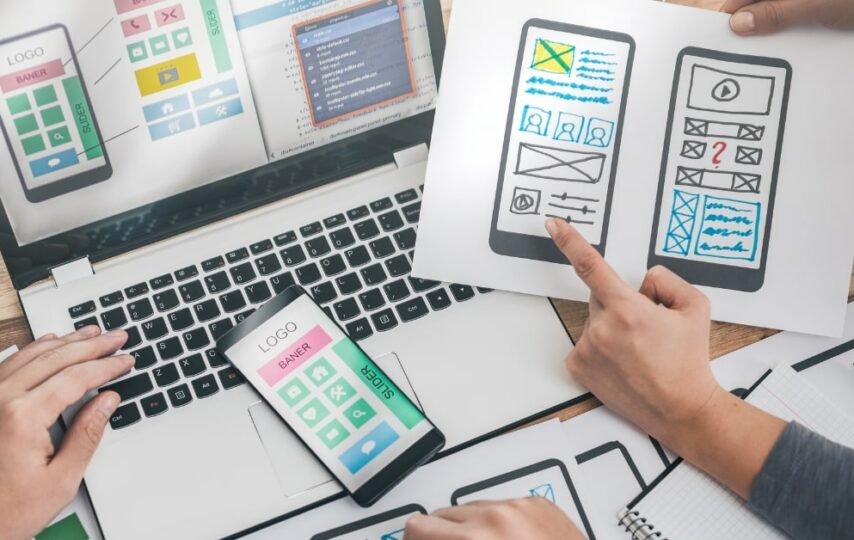In the present computerized age, portable applications have turned into a basic piece of our day to day routines. From requesting food to overseeing funds, from booking rides to remaining associated with loved ones, there is by all accounts an application for nearly everything. In any case, not all applications are made equivalent. The user experience (UX) design of an app frequently determines its success or failure. UX configuration assumes a significant part in application improvement, as it straightforwardly influences how clients connect with and see an application.
In this comprehensive guide, we will delve into the significance of UX (User Experience) design in application development and emphasize why it should always be given the utmost importance. Drawing on insights from The App Team, renowned experts in delivering exceptional user experiences, we will explore the critical role of UX planning and its impact on successful application development.
What is UX Design?
Understanding what UX design entails is essential before delving into the significance of UX design in app development. Client Experience configuration is a multidisciplinary approach pointed toward making items, for this situation, portable applications, that are easy to understand, pleasant, and viable. It includes figuring out the clients’ necessities, inclinations, and ways of behaving, and afterward planning the application’s connection point and collaborations to meet those prerequisites. UX design aims to ensure that users have a positive emotional experience while using the app by making it easy for them to move around it and complete their tasks quickly.
Enhanced User Satisfaction and Retention
The impact on user satisfaction of UX design on app development is one of the primary reasons why it is so important. At the point when clients find an application simple to utilize and pleasant, they are bound to remain connected with and return for future collaborations. Positive client encounters lead to higher client standards for dependability and expanded application utilization, which, thusly, can convert into better client unwaveringly and brand notoriety.
Then again, an inadequately planned application with confusing route, slow execution, or a jumbled connection point can disappoint clients, prompting negative surveys and high uninstall rates. Negative experiences not only turn off current users, but they can also discourage potential ones from trying the app at all. In the present cutthroat application market, keeping a client base is fundamental for an application’s prosperity, and that is where UX configuration comes in.
Improved Usability and Accessibility
The fundamental goal of UX design is usability. An intuitive software should enable users to complete activities with a minimum of effort and cognitive burden. Users can rapidly learn how to use an app if it is user-friendly, eliminating the need for lengthy tutorials or training. Users can locate what they need and carry out their intended actions with ease thanks to easy navigation and clear, consistent interface elements that contribute to a smooth user experience.
A crucial component of UX design is accessibility, which makes sure that apps are useable by users of all abilities. An inclusive design philosophy takes into account users with disabilities and aims to offer features that meet their requirements. Developers can reach a larger audience and uphold ethical standards by making an app accessible.
Reduced Development Costs and Time
Investing in user experience design early in the app development process can actually save time and money in the long run, despite the fact that this may appear counterintuitive. Before writing a lot of code, developers can identify and address potential usability issues by conducting user research and creating wireframes and prototypes.
Fixing ease of use issues during the advancement stage is significantly more financially savvy than attempting to determine them after the application has been sent off. The saying “measure twice, cut once” holds true here. By approving plan choices through client testing and criticism, designers can keep away from exorbitant upgrades and redevelopments, at last decreasing generally advancement time and costs.
The Role of User Research in UX Design
The target audience must be properly understood by developers in order to produce an engaging user experience. Here is when user research is useful. In order to better understand users’ requirements, preferences, and pain spots, user research is conducted. User testing, focus groups, interviews, questionnaires, and other techniques are all used to perform user research.
Developers can discover user personas, make empathy maps, and comprehend user journeys by performing user research. These insightful facts can guide design choices and assist programmers in modifying the app to satisfy user demands.
UX Design and Mobile App Testing
UX design iteratively includes ongoing testing and improvement. An app should go through extensive testing with actual users after its basic design has been established. Developers can monitor how users engage with the software, what problems they encounter, and what enhancements are required by conducting usability testing.
Developers can make the necessary adjustments and improvements based on user testing input to further improve the UX of the app. The app may need to be adjusted several times before it meets or surpasses user expectations.
Balancing Functionality and Simplicity
Finding the ideal mix between functionality and simplicity can be difficult in UX design. While offering consumers a variety of options and capabilities is vital, it can be detrimental to overwhelm them with a cluttered interface. Users may become frustrated and disengaged if an app is too complicated, which might cause confusion.
A successful software strikes the right balance between providing necessary capabilities and preserving a simple, clear user experience. Each feature should have a distinct function and enhance the user experience. Users’ wants should be taken into account when prioritizing functionality, and any extraneous aspects that can confuse or annoy users should be removed.
Adapting to Changing User Behavior and Expectations
User behavior and expectations evolve over time, influenced by technological advancements, design trends, and user interactions with various applications. To remain relevant and competitive, app developers must continuously adapt their UX design to reflect these changes.
Regularly updating an app’s design not only keeps it fresh and engaging for existing users but also attracts new users who appreciate modern, intuitive interfaces. By staying attuned to user feedback and tracking user behavior within the app, developers can identify areas for improvement and implement changes to keep the app aligned with user expectations.
Conclusion
In conclusion, UX design is a crucial, not a choice, part of creating an app. Its significance lies in its ability to shape how users perceive and use an app. A successful UX design can boost user interaction, conversions, and contentment, all of which will ultimately help an app succeed. If they want to compete in the intensely competitive app industry, developers must prioritize UX design throughout the development process and constantly iterate depending on user feedback to provide an excellent user experience.








